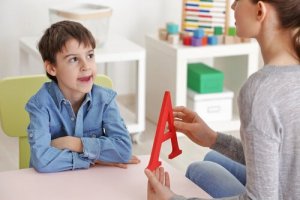Specific Language Impairment in Children

People of all ages and walks of life can have language problems. From very complex issues that make communication impossible, to simple things such as confusing the letter “r” with the letter “l”. Most of these problems are especially common during childhood when language development and learning are at their peak. One type of childhood language disorder is called specific language impairment, or SLI.
Children’s brains develop in leaps and bounds. Their most complex cognitive functions develop incredibly quickly. Language is one of the most important, considering the role it has played in our evolution as a species. The ability to communicate in different ways broadened the range of coordinated activities within the reach of human beings.
Nevertheless, language is also an extremely complex skill that children acquire and polish while they’re young. Most language disorders start during childhood. If left untreated, they can cause problems later in life.

What’s a specific language impairment?
Specific language impairments happen to children who have some kind of learning delay or disability. Given that cognitive abilities vary from person to person, experts talk about SLI in cases where there’s a specific impairment.
While the impairment might compromise other skills as well, it’s generally a selective deficit for certain learning, not a global one. The best-known example is dyslexia. People with dyslexia have trouble learning to read and write in spite of possessing a normal level of intelligence.
Brain maturation and language development
Language development is gradual and it depends on correct neural development in the brain. Spontaneous language starts at age two, and that coincides with significant motor development. This process coincides with an increase in the grade of myelination in the neurons of the nervous system.
At six months of age, for example, thanks to motor development and a baby’s ability to interact with others, it’s possible for them to smile. Another example is a five-year-old who has almost completed motor development and can perform more complex verbal tasks than saying their age or repeating four numbers.
What happens in cases of early brain damage?
Early brain damage tends to be the result of some kind of accident. The first potential deficiency is caused by the injury itself, due to adjacent neural changes from damage to the nervous system. Learning abnormalities happen later on. They’re a product of reorganization.
Neuroplasticity in children makes functional restructuring possible, but that doesn’t eliminate the possibility of some kind of developmental impairment. The type of injury will determine whether the impairment will be diffuse or focused.
Dyslexia
Dyslexia is a learning disorder involving difficulty reading due to problems with the order of words, syllables, and letters.
This is the most common specific language impairment. It can be the result of a basic problem with auditory processing and a visual-perceptive impairment. It’s interesting to note that the impairment varies depending on the writing system in question.
How to identify dyslexia
Children with dyslexia have problems correctly perceiving elements of written language. Four possible expressions of dyslexia are:
- Trouble paying attention. Certain tasks require too many cognitive resources, which leads to mental fatigue and trouble focusing or concentrating.
- Laterality problems. Having a hard time identifying left and right and general spatial problems.
- Difficulty recognizing and naming the different fingers.
- Feelings of insecurity and stubbornness.
What’s the difference between dyslexia and dyscalculia?
People with dyslexia don’t have specific issues with numbers. Their impairment involves having a general difficulty understanding abstract concepts related to language.
Dyscalculia, on the other hand, is the inability to mentally work through number problems. To diagnose dyscalculia, therapists look for:
- Difficulty learning and remembering basic operations.
- Problems identifying and correctly using signs.
- The inability to count in your head. Using more rudimentary strategies such as counting with your fingers.
- Trouble understanding numerical concepts such as “greater than”.
- Problems with the abstract and spatial representation of numbers which leads to difficulties with writing numbers.
Differences between specific language impairments and intellectual disability
Specific language impairments, as we mentioned above, are developmental problems that occur only with language. However, they can affect other areas of the brain.
Intellectual disability, on the other hand, is an overall alteration in intellectual function. It manifests in the early stages of development as lower-than-average intellectual abilities.
Specific language impairments: Evaluation and treatment
Usually, a multidisciplinary team works together to diagnose specific language impairments. The team often includes:
- A speech therapist. In charge of identifying what language area is producing the impairment.
- A neuropsychologist. In the case of a brain injury, the neuropsychologist evaluates executive function. They can also make a differential diagnosis to rule out other problems.
- A psychologist. Responsible for dealing with the emotional side of having a language impairment. Many children with learning disabilities have issues at home.
- A teacher. Teachers are a crucial part of the team because they’re usually the ones to identify the problem at school.
- Other specialists. Neurologists, doctors, and psychiatrists may also intervene in the case of a brain injury or another physical cause.

Treatment
Treating specific language impairments also involves more than one specialist. After identifying the specific impairment, the team develops a strategy to correct it.
The speech therapist is usually the one who provides the patient with exercises to improve their language skills.
For example, when a child has a phonetic impairment that makes them mispronounce words (replacing “l” with “r”, for example) the speech therapist will develop a set of motor and linguistic articulation exercises to correct the position of the mouth.
The intervention changes depending on the kind of specific impairment the child has. In this stage, teacher involvement in language and listening is crucial. They should pay special attention to language comprehension and expression problems.
It’s important to involve a psychologist in the treatment process due to the emotional problems that often slow patients’ progress.
In conclusion, it’s important to point out that children have a high level of brain plasticity because they’re still forming those important connections. That’s why it’s so important to treat language impairments as soon as possible.
If you treat a child’s dyslexia as early as possible, they can develop strategies and skills to compensate for their impairment. With treatment, you can avoid problems later in life, as it’s much more difficult to correct issues in your twenties and thirties.
This text is provided for informational purposes only and does not replace consultation with a professional. If in doubt, consult your specialist.








